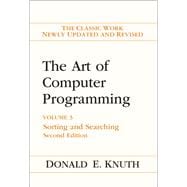
Note: Supplemental materials are not guaranteed with Rental or Used book purchases.
Purchase Benefits
What is included with this book?
Donald E. Knuth is known throughout the world for his pioneering work on algorithms and programming techniques, for his invention of the Tex and Metafont systems for computer typesetting, and for his prolific and influential writing. Professor Emeritus of The Art of Computer Programming at Stanford University, he currently devotes full time to the completion of these fascicles and the seven volumes to which they belong.
|
1 | (392) | |||
|
11 | (62) | |||
|
11 | (11) | |||
|
22 | (13) | |||
|
35 | (12) | |||
|
47 | (26) | |||
|
73 | (107) | |||
|
80 | (25) | |||
|
105 | (33) | |||
|
138 | (20) | |||
|
158 | (10) | |||
|
168 | (12) | |||
|
180 | (68) | |||
|
180 | (17) | |||
|
197 | (10) | |||
|
207 | (12) | |||
|
219 | (29) | |||
|
248 | (132) | |||
|
252 | (15) | |||
|
267 | (21) | |||
|
288 | (11) | |||
|
299 | (12) | |||
|
311 | (6) | |||
|
317 | (26) | |||
|
343 | (5) | |||
|
348 | (8) | |||
|
356 | (24) | |||
|
380 | (12) | |||
|
392 | (192) | |||
|
396 | (13) | |||
|
409 | (83) | |||
|
409 | (17) | |||
|
426 | (32) | |||
|
458 | (23) | |||
|
481 | (11) | |||
|
492 | (21) | |||
|
513 | (46) | |||
|
559 | (25) | |||
| Answers to Exercises | 584 | (164) | |||
| Appendix A -- Tables of Numerical Quantities | 748 | (4) | |||
|
748 | (1) | |||
|
749 | (1) | |||
|
750 | (2) | |||
| Appendix B -- Index to Notations | 752 | (5) | |||
| Index and Glossary | 757 |
The New copy of this book will include any supplemental materials advertised. Please check the title of the book to determine if it should include any access cards, study guides, lab manuals, CDs, etc.
The Used, Rental and eBook copies of this book are not guaranteed to include any supplemental materials. Typically, only the book itself is included. This is true even if the title states it includes any access cards, study guides, lab manuals, CDs, etc.